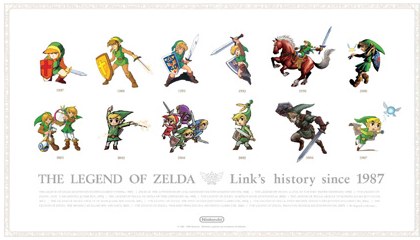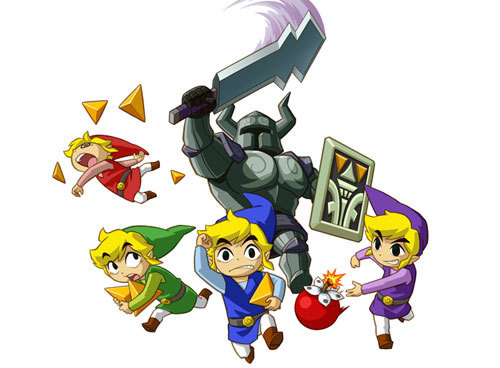Appraising the Art of Combat pt.10
 Monday, January 24, 2011 at 8:37PM
Monday, January 24, 2011 at 8:37PM Sometimes I play games to get tournament ready as quickly as possible. I search for powerful techniques and practice effective strategies to give me the edge in competition. But for Zelda: Spirit Tracks battle (STbattle), I started playing because the game looked neat. So I wasn't looking for the game to sustain the riggers of tournament play. As I continued to play, I got better naturally. Regardless of my how seriously I took the game, as I improved I questioned the gameplay balance. As I developed the metagame, different elements of the combat seemed overpowered or useless at different periods. For example, bombs were hard to use at first. Or items were difficult to counter. But now I realize that understanding the balance, interplay barriers, and nuances of combat depends on understanding how all the design parts come together emergently. The best way to convey my developmental process is to detail the metagame.
 Zelda history = Zelda metagame?
Zelda history = Zelda metagame?
From wikipedia...
metagame is a broad term usually used to define any strategy, action or method used in a game which transcends a prescribed ruleset, uses external factors to affect the game, or goes beyond the supposed limits or environment set by the game. Another definition refers to the game universe outside of the game itself. In simple terms, using out-of-game information, or resources, to affect one's in-game decisions
This definition encompasses a lot of different concepts including...
- Collective learned gameplay strategies/techniques. BXR in Halo. Wavedashing in Melee. Snaking in Mario Kart DS.
- Behavioral trends. Teabagging in Halo. Quitting out of matches in Melee before the final stock is taken. Saying GG in StarCraft before dropping out. An unusual amount of "rocks" thrown at RPS tournaments.
- Modded controllers. Removing the spring in the L/R gamecube controllers (Melee). Removing pieces from the Xbox360 controller to make the D-pad more usable.
- Using cheats/glitches/exploits/guides. Keyboard locking in Puji. Using aim bots in PC games. Using modded systems to cheat in console games/handheld games. Messing with the router to gain advantages in online matches (called stand by or blue screening in Halo2.)
- Any larger, connecting, overarching fiction. Fan fictions of Kingdom Hearts. Transmedia franchises like the Halo (e.g. books/toys/movie). Dead Space comic. Zelda cartoons/toys/manga.
Because gameplay is the focus of the Critical-Gaming blog, by default I use the term "metagame" with a gameplay focus. I use it to mean the evolution of strategies and trends that mainly revolve around counters and interplay barriers.
Recall my article series title Eureka and the Unintuitive (particularly part.4). Think of coming into a full understanding of STbattle combat as having a Eureka moment where all the complexities listed in the previous post paint a perfect picture of next-level play. To reach this Eureka, I have to understand how the parts work together emergently. This mainly involves figuring out what counters what (interplay) and how these layers of counters stack up in a hierarchy. Understanding each counter can only be contextualized or created from the appropriate conceptual platform (i.e. you can only figure out that a move works as a counter when you're looking for a counter for a specific situation).
It's just like when I played soccer as a kid. My dad, who was my coach, would always stress that I work independently on my techniques like wall passes, ball handling, and chip shots. As a kid, I never understood why I should work on these things. When I got on the field, I was faster than everyone else, I could score, and I had limitless energy. In other words, in the game there was no opponent to force me into a situation where I would need those techniques/counters. Without experiencing such pressured situations, I couldn't grasp the function of those techniques. Why change if you have the dominant strategy?

Nooo. Red Link! Why?
So to put the combat of Zelda Spirit Tracks battle into perspective I will try to convey the metagame of interplay barriers based on my experience with the game. In developmental/chronological order:
- 1. The Basics. MOVE. Grab gems. Run away from Phantoms when they chase. If you can't do these things you will not win.
- 2. Limit Movement. Because gems drop all over the map and players are constantly on the move, limiting opponent's movement became the next developed counter. Bombs were too hard to use because opponents just maneuvered around them (there's plenty of space to do so). But pitfall switches were easy to understand and spamable. We fell into many pits.
- 3. Item Play. We began to see that in the late game, items have a powerful comeback effect for the losing player. To counter the comeback force we found sweet spots that involved staying just close enough to the losing player to steal the item or to cancel it (using a bomb or ROLLing them into a pit). If the losing player got a powerful item (thunder/invincibility) we were also ready to take a very defensive stance.
- 4. Phantom Control. After items became less of a tide turning factor, we sought other ways to gain significant advantages. Bombs were still tricky to use because they slowed player movement and were hard to land hits. Furthermore they only knock out 1/4 of the players' gems. With such little stun time, bombed players often picked up many of their own gems quickly after getting hit. So, influencing Phantoms became the next leap in strategy.
- As the game progresses in phases, phantom control gets more complex. Players who plan ahead can read and manipulate the position of Phantoms for devious strategies. Whether you lead a Phantom into other players or position them in areas to keep you safe, there's a lot you can do. However, because there's an inherent risk in Phantom manipulating, the next interplay stage of the metagame developed.
- 5. Precise Control/Aim. This is the final level of the metagame that we developed. Players with the greater chances of winning must play using (or at least understanding) all of the steps I previously described. These strategies must be used because they're interplay barriers. At any level but the highest level, you can be countered outright using the strategies of the next level.
- Staying in the item sweet spot and phantom control are tactics/strategies that make player movement more predictable and in some ways more limited. Now, finally, bombs are used effectively. When blocking off a ramp before (level 2 of the metagame) would merely force a player to take the long way around, now using phantom control taking the long road may be a costly trap.
- Furthermore, sweet spot positioning is harder than ever. With so many deadly trap combinations, sometimes the difference between winning and losing is a matter of how carefully you can control Link in the tightest of spaces, e.g., walking along the edge of a trap door or around a distracted Phantom. We've developed many techniques that are only effective at this stage of the metagame.
I tried to get video of a 4-for-all I played last weekend, but I was unsuccessful. The DS is so hard to film when you're playing it. I will continue to try and get video of our next-level gameplay. In the meantime, don't underestimate the multiplayer of any game. Even if the game breaks down at a competitive level, reaching the breaking point is worth the trip.


Reader Comments